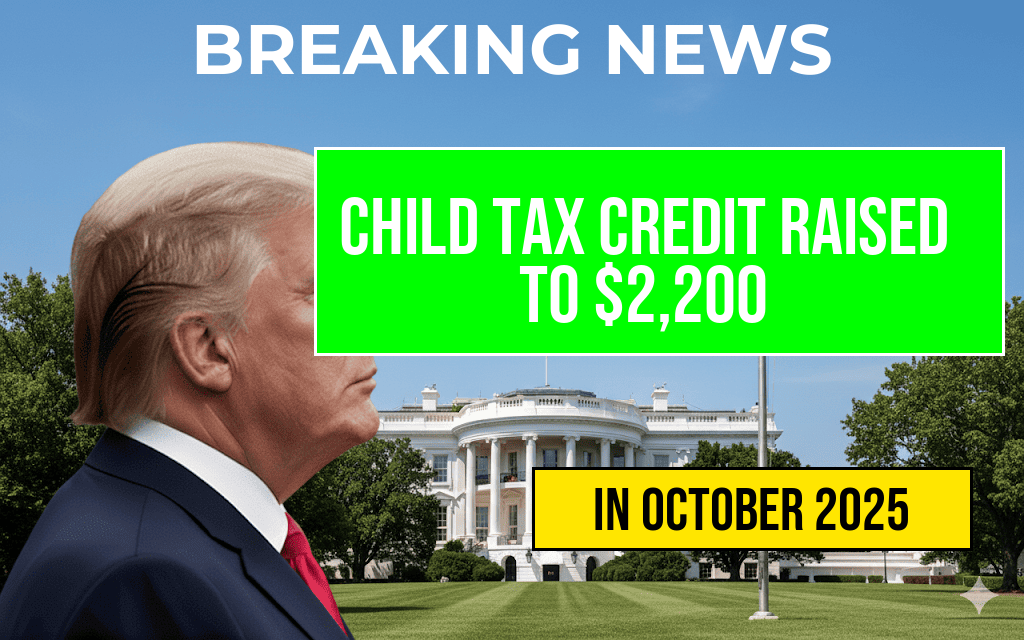The Child Tax Credit (CTC) has undergone a significant boost, increasing the maximum benefit to $2,200 per qualifying child. This adjustment aims to provide substantial financial relief to millions of American families, especially those with lower and middle incomes. The increase reflects recent legislative changes designed to address economic challenges faced by families across the country, offering more robust support for child-rearing expenses, education costs, and healthcare needs. The expanded credit is expected to influence household budgets nationwide, potentially reducing child poverty rates and fostering economic stability for vulnerable populations.
Background of the Child Tax Credit Enhancement
The Child Tax Credit has historically been a key component of the federal government’s efforts to support families. Originally established in 1997, the CTC has evolved through various legislative updates, most notably during the COVID-19 pandemic when temporary enhancements substantially increased the benefit amount and expanded eligibility. The recent legislative act, signed into law earlier this year, formalizes a permanent increase in the maximum credit to $2,200 per child, effective starting this tax year.
Details of the New Policy
| Aspect | Previous Policy | Current Policy |
|---|---|---|
| Maximum benefit per child | $2,000 | $2,200 |
| Age eligibility | Under 17 | Under 17 |
| Income phase-out threshold | $200,000 for single filers, $400,000 for married filing jointly | Remains the same, with adjustments for inflation in future years |
| Refundability | Partially refundable | Enhanced refundability, allowing more families to benefit fully |
The policy increase also introduces more flexible income phase-out thresholds, ensuring that higher-income families are minimally affected while maximizing support for lower-income households.
Impacts on Families and the Economy
Financial Relief for Households
For millions of families, the increase in the Child Tax Credit translates into tangible improvements in their monthly budgets. The additional $200 per child can cover a variety of essential expenses, including childcare, educational supplies, and healthcare costs. According to recent estimates from the U.S. Census Bureau, families with children under 18 are projected to see a reduction in child poverty rates by approximately 10% over the next year due to the enhanced benefit.
Broader Economic Effects
Experts suggest that increased financial support for families may stimulate broader economic activity. With more disposable income, families are more likely to spend on goods and services, which can bolster local economies and support job growth. Furthermore, by alleviating financial stress, the policy may contribute to improved child health and educational outcomes, which have long-term benefits for workforce development and economic stability.
Implementation and Future Outlook
The IRS has outlined plans to streamline the distribution process, ensuring that eligible families receive the increased benefit without delays. This includes a combination of monthly payments and streamlined tax filings, reducing the administrative burden for recipients. The IRS also announced it will enhance outreach efforts to inform eligible families about the new credit, aiming to minimize gaps in awareness or access.
Legal and Political Context
The increase in the Child Tax Credit is part of a broader legislative package focused on economic support and social welfare. While the policy enjoys bipartisan support, some lawmakers continue to debate the scope and funding mechanisms of such programs. Nonetheless, recent polling indicates widespread public approval, especially among low- and middle-income voters who stand to benefit most.
Additional Resources and References
Frequently Asked Questions
What is the new amount for the Child Tax Credit?
The Child Tax Credit has been increased to $2,200 per qualifying child, providing greater financial support to families.
Who is eligible for the increased Child Tax Credit?
Families with qualifying children under the age of 17, who meet income requirements, are eligible to receive the increased Child Tax Credit.
When will families start receiving the increased Child Tax Credit payments?
Eligible families can expect to start receiving the enhanced Child Tax Credit payments with upcoming tax refunds or monthly disbursements, depending on their filing status and payment schedule.
How does the increased Child Tax Credit impact low- and middle-income families?
The increase in the Child Tax Credit aims to provide greater financial support to low- and middle-income families, helping to cover essential child-related expenses and reduce child poverty.
Are there any recent changes or extensions to the Child Tax Credit program?
Yes, recent legislation has temporarily increased the amount of the Child Tax Credit to $2,200 and expanded eligibility, offering increased support for families during this period.






